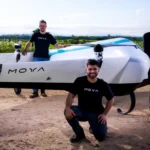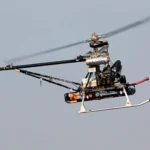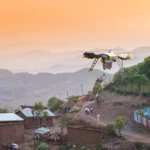The quick exponential growth in the market of the professional drones, sets important issues in the aeronautical and aerospace sectors. The continuous growth in the unmanned aerial platforms development creates a real expectation of an international overcrowded sky.
This will not only make our daily actions be totally transformed, but also there will have to be new regulatory frameworks and normatives. These will have to allow that the air space be safe, feasible, profitable and synonyms of a safer future where all our life will have bird’s eye view.
Before this conviction, one of the first handicaps for the professional drone and UAV universe is to avoid the possibility of a possible collision with other surrounding aircrafts in the same area and/or trajectory, which is possible due to the exponential growth of the unmanned aerial platforms in the last years. Because of this, companies like Embention have developed and implemented the ADS-B system, an innovative way to create a safe air space.
The ADS-B or Automatic Dependent Surveillance System is an increasingly present technology in the UAV sector. The need to control the traffic of the remotely piloted systems is being a topic of discussion not only in the public sphere but also for those companies leading the drone industry.
How the ADS-B Decoder works?
ADS-B (Automatic Dependent Surveillance – Broadcast) allows a controlled flight thanks to its GNSS signal in the national territory, so that it is much easier for the pilot or operator to set a safe mission without a danger of collision.
This fact makes the ADS-B in a next generation system for air transport. In countries like Australia their use is already compulsory and in the USA it is going to be regulated soon.
For this reason, the presence of this device in the professional UAVs, is an essential tool to grant the safety and efficiency of an air traffic highly controlled.
Veronte, a brand belonging to Embention, integrates among its functions the compatibility of their autopilots with most of the external ADS-B systems in the market. Besides, the new version of the Veronte autopilot offers, optionally, the possibility of integrating a last generation internal ADS-B, signed by the Polish company, Aerobits.
The idyllic view of an aerial ecosisteme populated by drones, where most of the transport, logistic and humanitarian tasks are carried out by UAVs, is just one of the pillars on which Embention sits.
For that, the need of creating a subtle, automatic and definitive control in the ADS-B systems of our autopilots, has pushed us to create a new added value, the sense and avoid algorithm in the Veronte autopilot.
Sense and Avoid Algorithm
This algorithm allows us to distinguish obstacles within our field of vision, a plus that is not available in the autopilots from other companies.
In most of the cases, these modules only detect other objects by using a lidar but are unable to make the appropriate maneuver automatically, an action that Veronte effectively performs.
Once the object has been detected, Veronte will order an automatic maneuver to avoid it in the direction that the autopilot itself identifies as the best option to , afterwards, continue with its original route.
All this happens without human manual or assisted control when two objects meet.

Compatibility of ADS-B with the Veronte autopilot
Nowadays there is a wide range of high reliability ADS-B systems compatible with our algorithm Sense&Avoid, The Aerobits, Sagetech or UAVionix catalogue for example with its models ADS-B Transceiver ping 1090/1090i, ADS-B Transceiver ping 2020/2020i y ADS-B Receiver ping Rx, have a perfect compatibility with the Veronte autopilot.
In Embention we always create maximum efficiency solutions, customized for every single client. For this reason we adapt our systems to the most demanding projects offering therefore totally personalized solutions.




